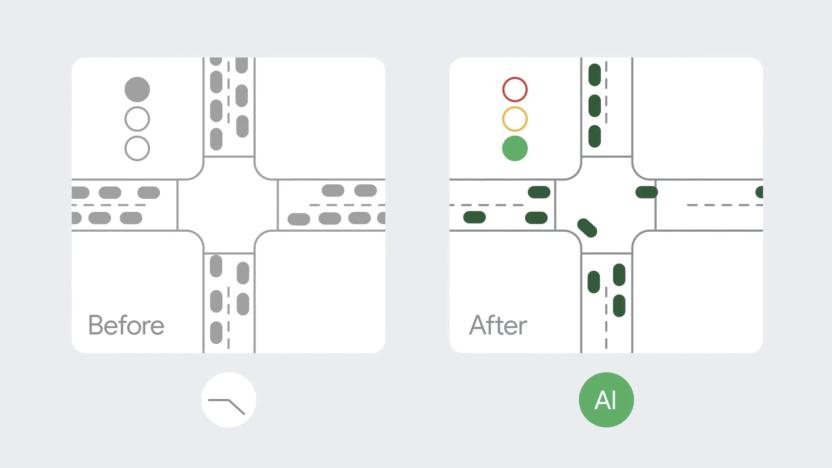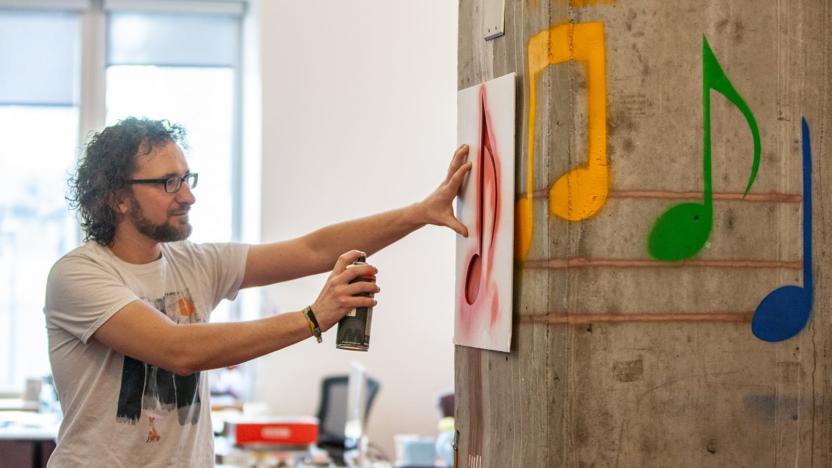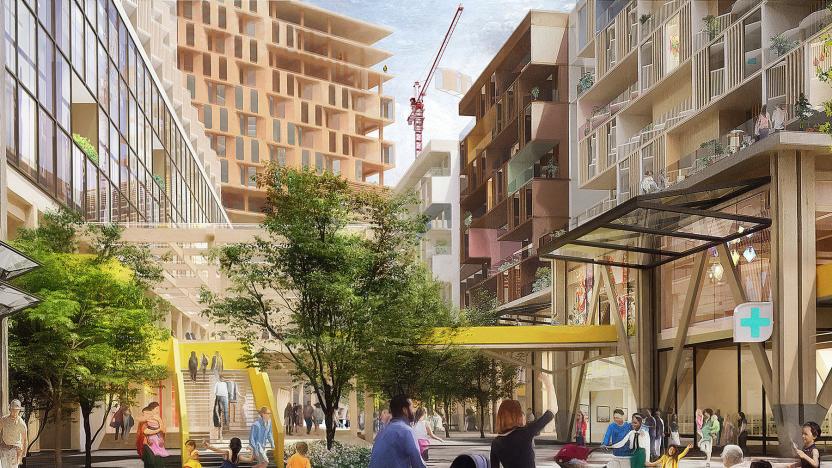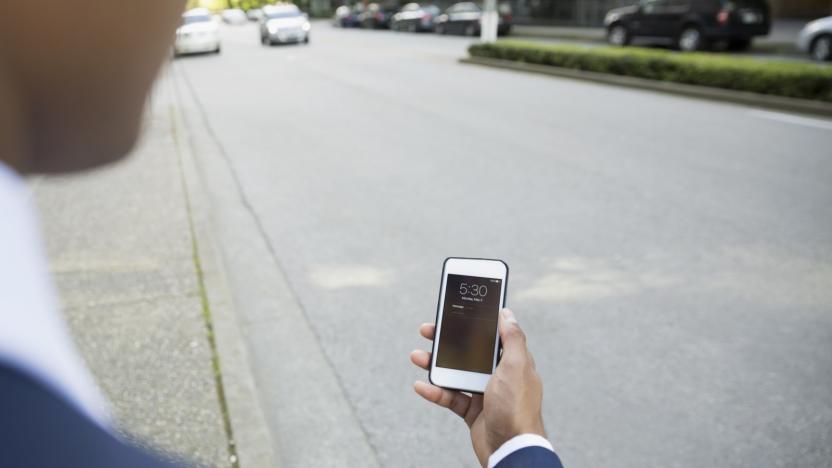smart cities
Latest

Google turns its AI on traffic lights to reduce pollution
Google is working on a project that could use AI to make traffic lights more efficient and, as a result, decrease pollution in general.

MIT project turns spray paint into a functional user interface
Scientists from MIT have developed a way to create interactive surfaces using airbrushed inks -- or in other words, graffiti that actually does stuff. The SprayableTech system lets users create room-sized interactive graphics with sensors and displays that can be applied to everything from walls to furniture. Spray-painted art on walls can be used to turn lights on and off, for example, while designs airbrushed onto the arm of a couch can be used to control a TV. After designing the interactive artwork with a 3D editor, the system generates stencils for airbrushing the layout onto a surface. Then a series of inks are applied -- conductive copper ink, paint, dielectric, phosphor, copper bus and a clear conductor -- and then a microcontroller is attached, connecting the interface to a board that runs the code for sensing and output. The system hinges largely on the stencil design phase, to ensure the inks are placed in the right places and can connect to the microcontroller properly, so at this stage there's not much opportunity for spontaneous exploration -- you couldn't just spray a design on the wall and expect it to control your lights, for example. But the team is now working on creating modular stencils, potentially allowing users to try the system at home without needing to use a 3D editor or cut out stencils themselves. And looking ahead, the team has even bigger plans. Michael Wessely, lead author on the paper about SprayableTech, says, "We view this as a tool that will allow humans to interact with and use their environment in newfound ways. In the future, we aim to collaborate with graffiti artists and architects to explore the future potential for large-scale user interfaces in enabling the internet of things for smart cities and interactive homes."

Toronto rejects some of Sidewalk Labs’ smart neighborhood ideas
Sidewalk Labs will have to cede a little more ground on its vision for Quayside, a planned smart neighborhood in Toronto. The company, which is owned by Google-parent Alphabet, published a draft version of its Master Innovation and Development Plan (MIDP) last June. The technical document, which spans four volumes and almost 1,000 pages, is packed with proposals for how the district should be designed, funded and governed. Waterfront Toronto, a tri-government organization spearheading the city's lakeside overhaul, has now completed a technical evaluation of the draft MIDP, which will help its board decide whether to approve the project or sever ties with Sidewalk Labs entirely.

Sidewalk Labs finally publishes its smart city master plan
Better late than never. Sidewalk Labs, the part of Alphabet focused on cities and urban development, has unveiled its Master Innovation and Development Plan (MIDP) for a proposed smart neighborhood on Toronto's Eastern Waterfront. The MIDP is called a "draft," but it's the first official pitch document that sets out the company's vision for the area. It will be scrutinized by Waterfront Toronto, a publicly-funded organization, and ultimately, voted on by its board and the Toronto city council in late 2019 and early 2020. If it goes through, Sidewalk hopes to begin construction on the first part -- a site called Quayside -- before 2021. The company has shared morsels of its smart city vision before. These include the 200-page document that helped it secure the project -- that is, the right to develop the MIDP -- back in October 2017. Since then, Sidewalk Labs has been stuck in a research phase, consulting with experts and gathering public feedback. The team has shared some, but not all of its evolving ideas through a mixture of live events, blog posts, PDF presentations and podcasts. These snippets, it always emphasized, were exploratory and subject-to-change ahead of its all-important MIDP. The document, even in draft form, solidifies the company's thinking. It also gives Toronto residents their clearest picture yet of what a smart neighborhood spearheaded by Sidewalk Labs -- and by extension, Google -- might look like. Below, we've summarized the main features that will likely spark debate in the coming months.

Open Curbs database could make it easier to catch an Uber
Curb data can be intensely useful to city planners and transportation companies alike, but it's usually fenced off. What if everyone had access to it? They will now. Alphabet spinoff Coord has launched Open Curbs, a public repository for curb info like parking signs, fire hydrants and other vital details. The information could help cities identify safe places for delivery and ride hailing stops, not to mention aid in urban planning as the transportation grid evolves.

NHS vehicles trial tech that turns traffic lights green on command
Traffic lights are a pet peeve for many city-dwelling drivers. You'll be running late for a meeting, but all of your attempts to make up the time are thwarted by successive red lights. Bad luck on the road can be particularly problematic for ambulances in the UK -- when they're rushing to the scene of an accident, every second counts. To help out, Newcastle University is spearheading a new project that gives NHS vehicles priority at the lights.

IBM and Portland team up to see into city's future
Is it possible to see into a city's future? Perhaps, if you're backed by a company like IBM. The computing giant has teamed up with Portland, Oregon for its Systems Dynamics for Smarter Cities program, creating a simulation of the city (a veritable "Sim City," as it were), so governmental leaders can see the ways in which public policies might affect its future. IBM approached the northwestern cultural mecca back in 2009, working with representatives from a number of professions, including teachers, economists, city planners, and business leaders in the interim. The information collected was combined with governmental data to create a computer-based model of the city. Among other things, city leaders have used the model to work out a plan to reduce the city's carbon emissions 80 percent by the year 2050. Add in a guide to those famous Portland food carts and we'll be 100 percent behind the project.

MIT developing carbon-free, stackable rental cars
Sure, we know you love actually owning a car, but let's be honest -- in large cities with condensed layouts, your H3 doesn't make a lot of sense. A group of researchers at MIT have been hard at work developing a solution that's kind on the planet and your scrawny legs. A team called Smart Cities have designed a small, two-seat, electric vehicle -- which they call the City Car -- that can be "stacked" in convenient locations (say, just outside a subway stop), and then taken on short trips around urban areas. The cars -- which are based around an omnidirectional "robot wheel" that encases an electric motor, suspension, and steering -- can be "folded" and attached to a group of other cars for charging. The lineups of rentable vehicles would be accessible from various points around a city, with six or eight cars occupying just a single "regular" car space. Of course, you'll have to forgo your 24-inch rims... but that's life.[Via Technology Review]




